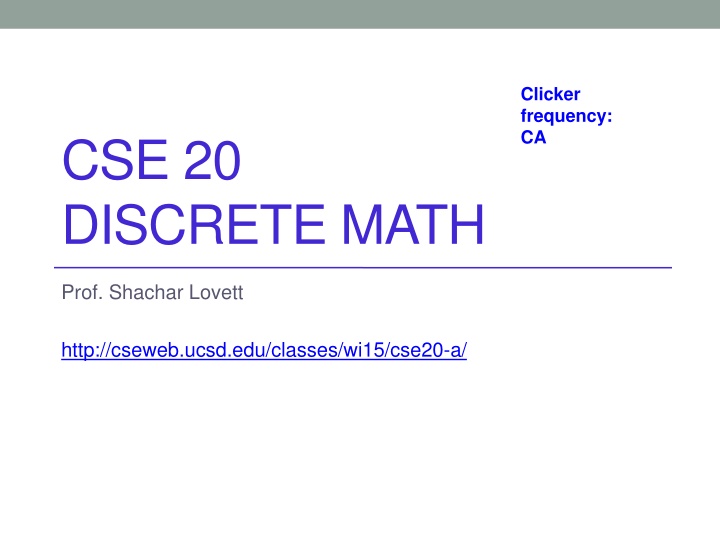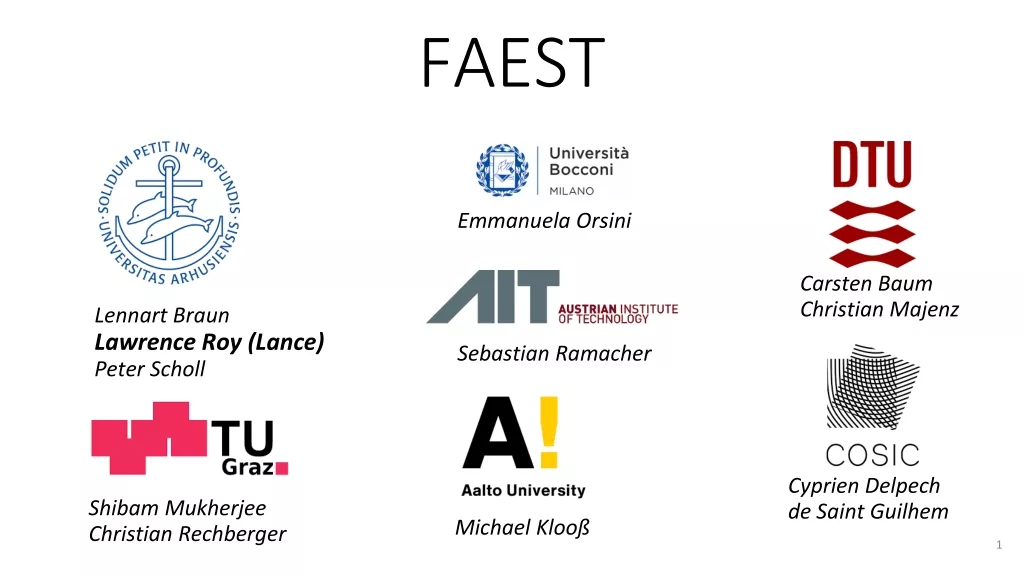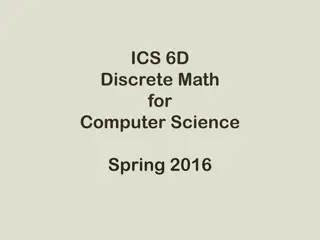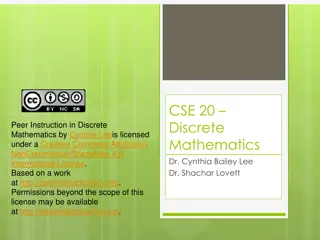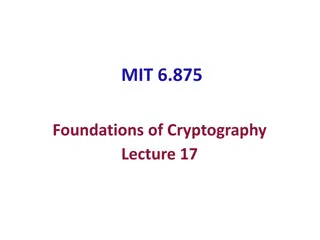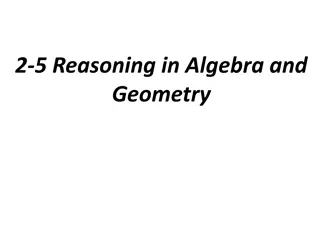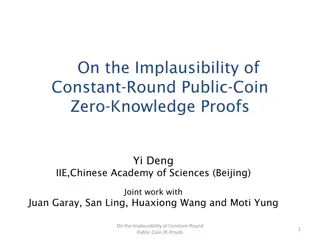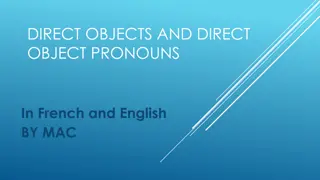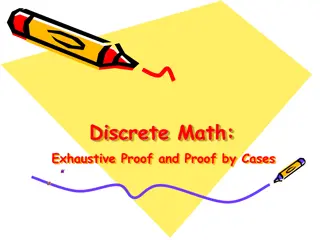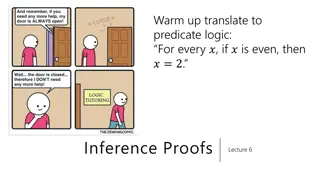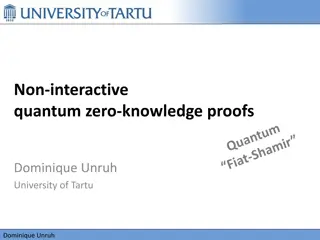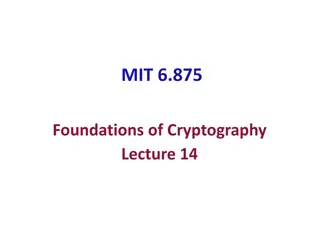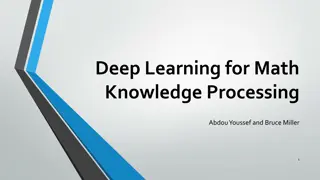Guide to Direct Proofs in Discrete Math
Dive into the world of direct proofs in discrete math with this comprehensive guide. Learn how to prove implications, create truth tables, and follow a step-by-step direct proof template. Test your understanding with engaging quizzes and practical examples. Master the art of logical reasoning and formal argumentation with ease.
Download Presentation

Please find below an Image/Link to download the presentation.
The content on the website is provided AS IS for your information and personal use only. It may not be sold, licensed, or shared on other websites without obtaining consent from the author.If you encounter any issues during the download, it is possible that the publisher has removed the file from their server.
You are allowed to download the files provided on this website for personal or commercial use, subject to the condition that they are used lawfully. All files are the property of their respective owners.
The content on the website is provided AS IS for your information and personal use only. It may not be sold, licensed, or shared on other websites without obtaining consent from the author.
E N D
Presentation Transcript
Clicker frequency: CA CSE 20 DISCRETE MATH Prof. Shachar Lovett http://cseweb.ucsd.edu/classes/wi15/cse20-a/
Todays topics Direct proofs Section 3.5 in Jenkyns, Stephenson
Truth table for implication Note there is only one F This is when p the if part is true, and the then part is false To prove an implication is true, we must show this F row cannot happen p T T F F q T F T F p q T F T T
Proving an implication pq Procedure: 1. Assume p is true (take it as given ) 2. Show that q logically follows, in other words, derive q just from: The assumption that p is true Definitions Axioms Includes basic algebra and math laws Applying logical rules/valid argument forms
Direct Proof Template Thm. [write the theorem to be proved if p, then q. ] Proof: Given: Assume [p]. WTS (Want To Show): [q]. This is clearly identifying to the reader what you will be trying to reach in the main body of the proof. Main body of the proof: Using p, try to end up with q. end with [q], which is what was to be shown." This clearly identifies for the reader that you reached what you said you were going to reach in the WTS section.] Conclusion: Therefore, [restate theorem]. QED.
Test yourself: Direct Proof Template For a theorem of the form: If p, then q. Given is where you make an assumption that p is true. What does this assumption really mean? A. p could be true or false, but we are just saying it is true for the sake of argument. B. p is always true. C. p is always false, but we are just saying it is true in the proof. D. p is guaranteed to be true within the scope of the proof. E. Other/none/more
Test yourself: Direct Proof Template Want to Show (WTS) is your goal for the main body of the proof. If your theorem is If it is raining, then I will need an umbrella, what is your WTS? A. If it is raining, then I will need an umbrella. B. Assume it is raining. C. I will need an umbrella. D. QED E. Other/none/more
Direct Proof Template: Mathematical Driving Directions
Test yourself: Direct Proof Template Thm. The sum of any two odd numbers is even. What are your Given and WTS? A. Given: Assume the sum of two odd numbers is even. WTS: This follows from axioms of algebra. B. Given: Assume x and y are odd numbers. WTS: x + y is even. C. Given: Assume 3 and 5* are odd. WTS: sum of 3 and 5 is even. D. You can t use Direct Proof Template for this theorem because it is not of the form If then . E. Other/none/more * You could pick something else but we just happened to pick 3 and 5
Proof Keywords: Introducing/declaring variables in the Given section As you know, the Given section announces that you are assuming the p part of the p IMPLIES q theorem is true Given: Assume x and y are odd numbers. But sometimes the word assume is replaced by other options meaning the same thing Given: Let x and y be odd numbers. Given: Suppose x and y are odd numbers.
Example Thm.: The sum of any two odd numbers is even. Proof: Given: Let x and y be odd numbers. WTS: z = x + y is even. Conclusion: So z is even, which is what was to be shown, therefore the sum of any two odd numbers is even.
What we have to work with Given: x and y are odd Definition: odd means an integer k such that [odd number] = 2k + 1. Definition: even means an integer k such that [even number] = 2k. Axiom: sum of two integers is an integer. algebra logic
Example Thm.: The sum of any two odd numbers is even. Proof: Given: Let x and y be odd numbers. WTS: z = x + y is even. Try it yourself first Conclusion: So z is even, which is what was to be shown, therefore the sum of any two odd numbers is even.
Rational numbers ? ?:? ?,? ? {0} Definition: ? = Theorem: The rational numbers are closed under addition and multiplication. What does that mean? Closed under addition: if ?,? ? then ? + ? ? Closed under addition: if ?,? ? then ?? ?
Rational numbers Thm: The rational numbers are closed under addition and multiplication. Proof: Given: Let x and y be rational numbers. WTS: x + y, xy are rational numbers. What can we use? Definition of rational numbers Basic arithmetic Axioms (which ones would we need?) Logic
Rational numbers Thm: The rational numbers are closed under addition and multiplication. Proof: Given: Let x and y be rational numbers. WTS: x + y, xy are rational numbers. Try it yourself first Conclusion: So, x+y and xy are rational numbers, which is what we needed to show. Hence the rational numbers are closed under addition and multiplication.
Next class More direct proof techniques Read section 3.5 in Jenkyns, Stephenson
